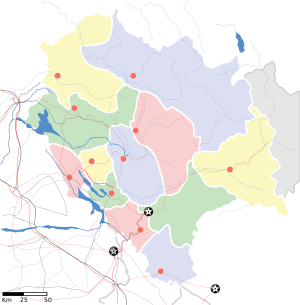Chaupal, Himachal Pradesh
| Chaupal | |
|---|---|
| City | |
|
Bijat Maharaj Temple in Village Sarain, Chaupal. | |
 Chaupal Location in Himachal Pradesh, India  Chaupal Chaupal (India) | |
| Coordinates: 30°57′N 77°35′E / 30.95°N 77.58°ECoordinates: 30°57′N 77°35′E / 30.95°N 77.58°E | |
| Country |
|
| State | Himachal Pradesh |
| District | Shimla |
| Government | |
| • BJP | Balbir Singh Verma |
| Area | |
| • Total | 8 km2 (3 sq mi) |
| Elevation | 2,550 m (8,370 ft) |
| Population (2011) | |
| • Total | 7,886 |
| • Density | 990/km2 (2,600/sq mi) |
| Languages | |
| • Official | Hindi |
| Time zone | UTC+5:30 (IST) |
| PIN | 171211 |
| Telephone code | 01783 |
| Vehicle registration | HP- 08, 08A, 08B, 08C |
Chaupal is a town and nagar panchayat (city council) in the Shimla district of the Indian state of Himachal Pradesh.Chaupal is a very rich in terms of flora and fauna, also the culture of this place is very amazing and distinct from other places in Shimla. It has a very good number of deodar trees i.e. Cedrus deodara and kail trees i.e. Pinus wallichiana. Chaupal receives very heavy snowfall in winters and experiences mild summers. People here are very kind, sweet and generous . Many regional dilacts are spoken here and all of them are commonly referred to as 'pahari' language . This place is quite developing but general people are rich in terms of money because of their apple orchards . They have good and beautiful homes , cattle sheds and most of the residents live near forests. Wildlife of this place is amazing , but due to recent hunting and poching of leopard there has been a tremendous decline in leopard population. The life here is simple , people are rich but still have cows, they farm lands and also most of the people here are fruits growers.
Geography
Chaupal is a Sub Division (administrative division) of Shimla District. It is surrounded by hills and forests of Deodars. It is also known for its densely covered areas of Himalayan Cedar trees in the city. This is one of the richest forest area of Himachal. Devdar,kail,fir spruce and ban trees are in plenty in forests of chaupal. Best quality Devdar in Asia are in Chaupal. The forest region of Chaupal is among the oldest Forest Department Divisions in the state; it is currently headed by Divisional Forest Officer Mohinder Singh Chandel.[1]
Demographics
According to the 2011 Indian census,[2] Chaupal had a population of 7886 people. Of the population, 58% are male, and 42% are female. Chaupal has a literacy rate of 89.65%.
Economy
This region is famous for the production of high quality apples,[3] which are exported internationally. Apple-growing areas in Chaupal include Chambi,Tharoch, Poran, Pauria, Peontra Valley, Bamta, Rinjat, Khaddar, Matal, Chanju (Chopal), Kashah, Rushlah, Satota (Halau, Shalan) Dewat, Kakhrona, Shilikyan, Shantha, Sunarli, Maraog, Bigraoli, Jhina, and Sarain.[4].In this tehsil, business speaks its words as it is well flourished & well diversified. People from different religions, communities & age groups are doing their respective businesses happily & peacefully for the last so many years.
Climate
Chaupal has a cool and moderate climate. Between December and March, the city gets heavy snow and the temperature can hover around freezing point. During the summer, the climate is warmer with temperatures around thirty degrees Celsius.
- Temp in Winter:−10 °C (14 °F) to 18 °C (64 °F)
- Temp in Summer:20 °C (68 °F) to 32 °C (90 °F)
| Chaupal | ||||||||||||||||||||||||||||||||||||||||||||||||||||||||||||
|---|---|---|---|---|---|---|---|---|---|---|---|---|---|---|---|---|---|---|---|---|---|---|---|---|---|---|---|---|---|---|---|---|---|---|---|---|---|---|---|---|---|---|---|---|---|---|---|---|---|---|---|---|---|---|---|---|---|---|---|---|
| Climate chart (explanation) | ||||||||||||||||||||||||||||||||||||||||||||||||||||||||||||
| ||||||||||||||||||||||||||||||||||||||||||||||||||||||||||||
| ||||||||||||||||||||||||||||||||||||||||||||||||||||||||||||
References
- ↑ "20 thousand liters seedar oil recovered at chaupal". Amar Ujala. 1 February 2018. Retrieved 28 January 2018.
- ↑ "Census of India 2001: Data from the 2001 Census, including cities, villages and towns (Provisional)". Census Commission of India. Archived from the original on 2004-06-16. Retrieved 2008-11-01.
- ↑ "Simla". npchopal.in.
- ↑ "Asia's Richest Villages". IndianRoots Daily (Blog). Retrieved 2015-12-28.